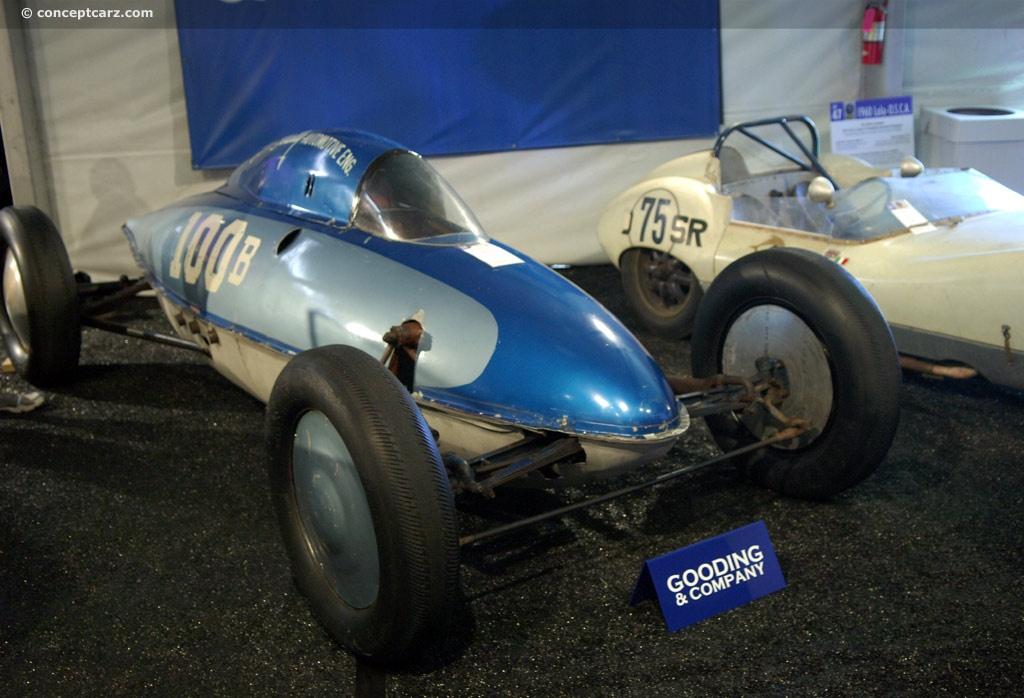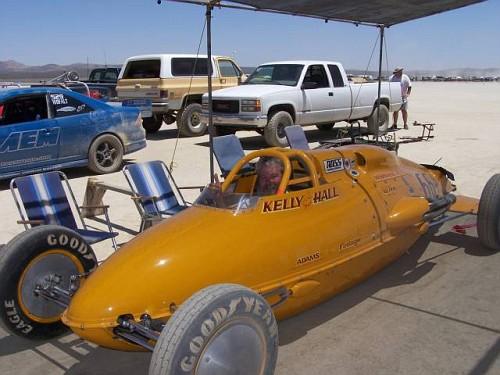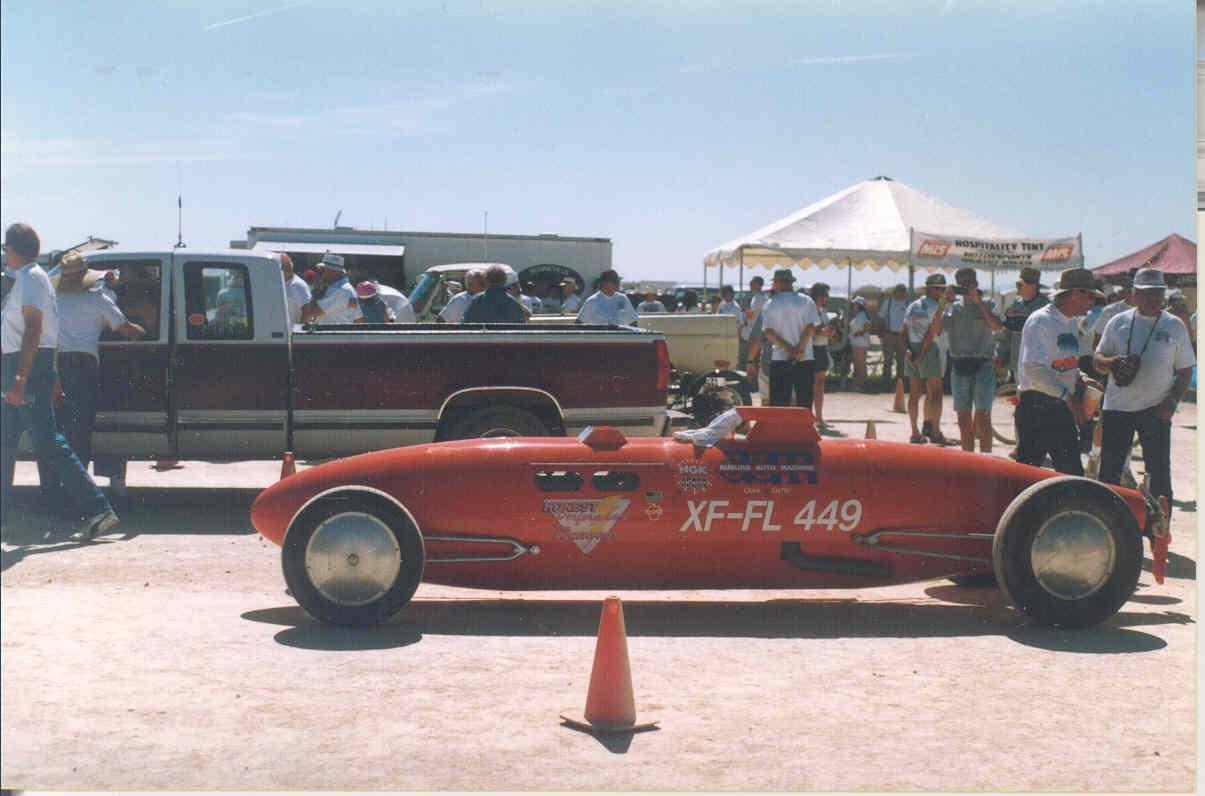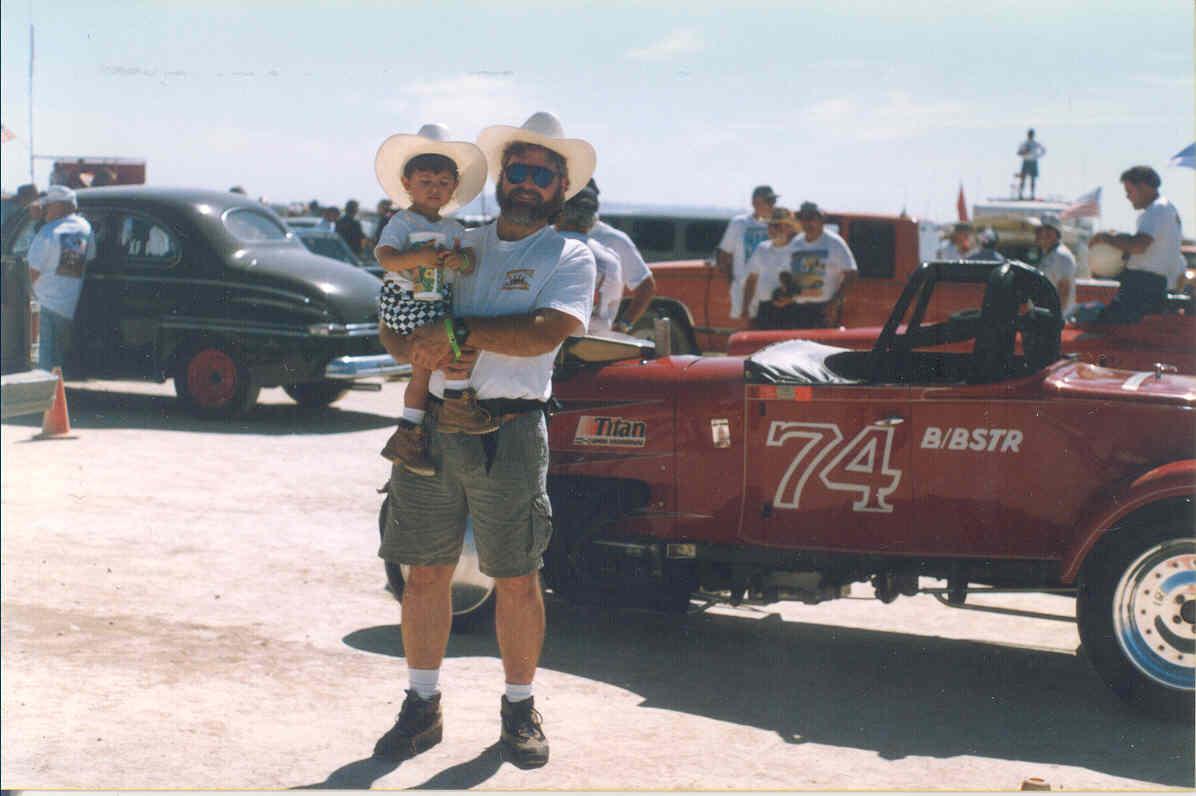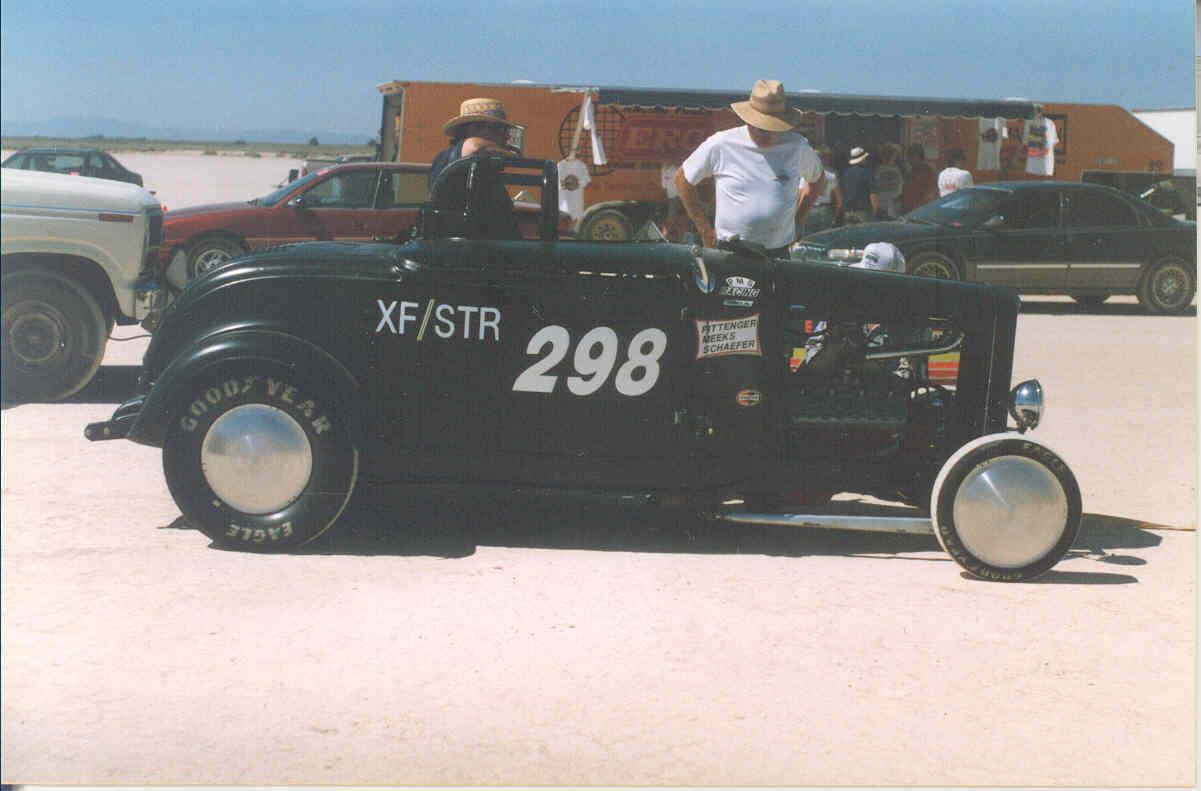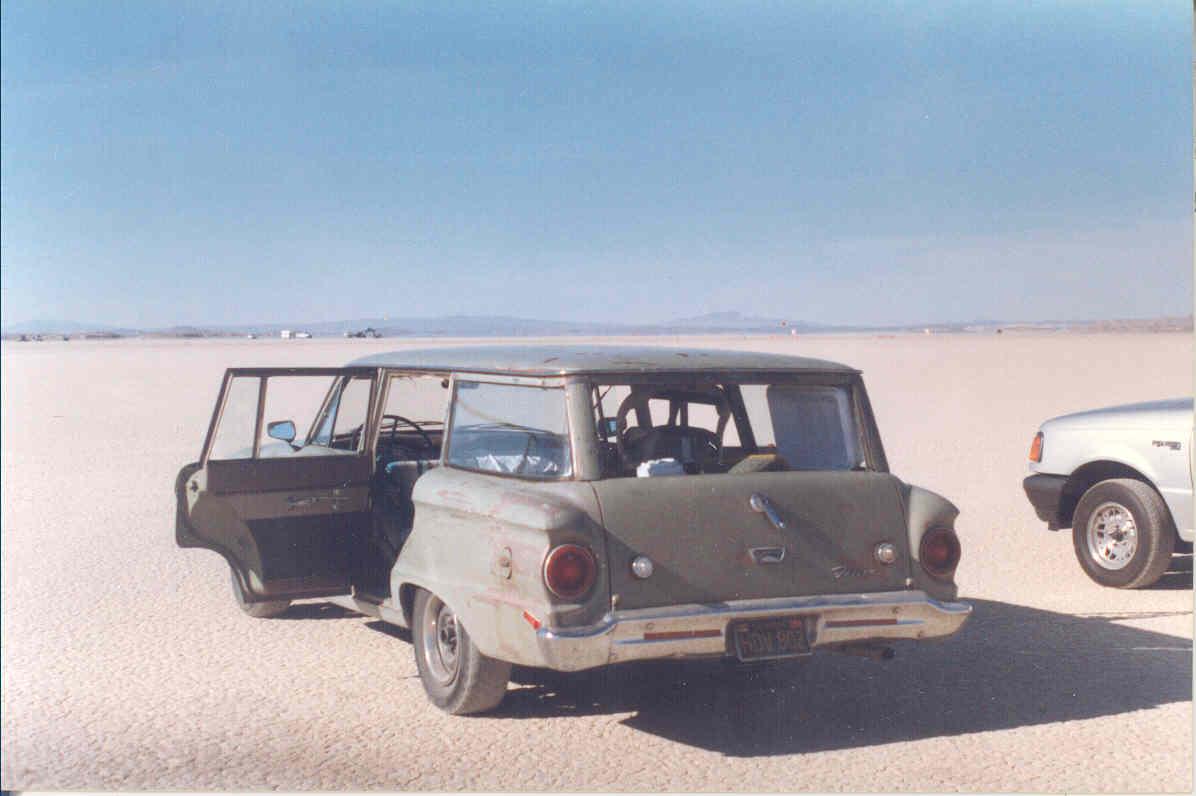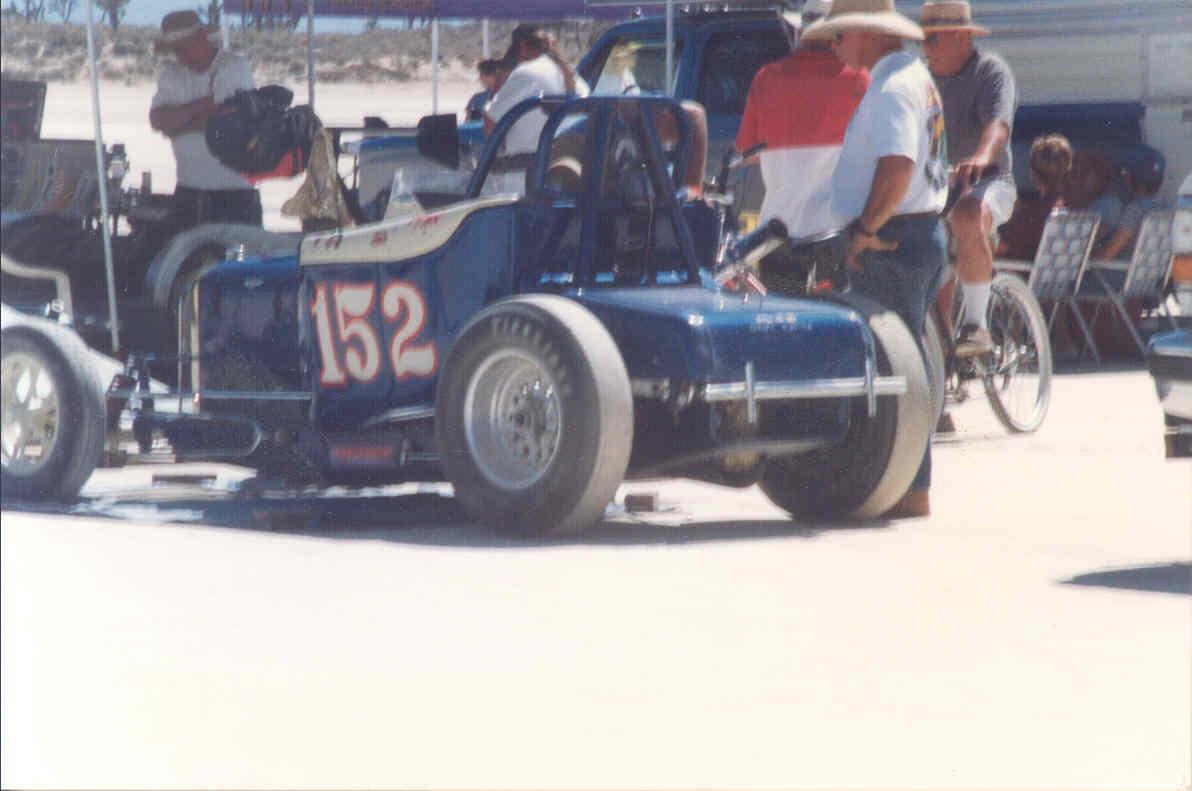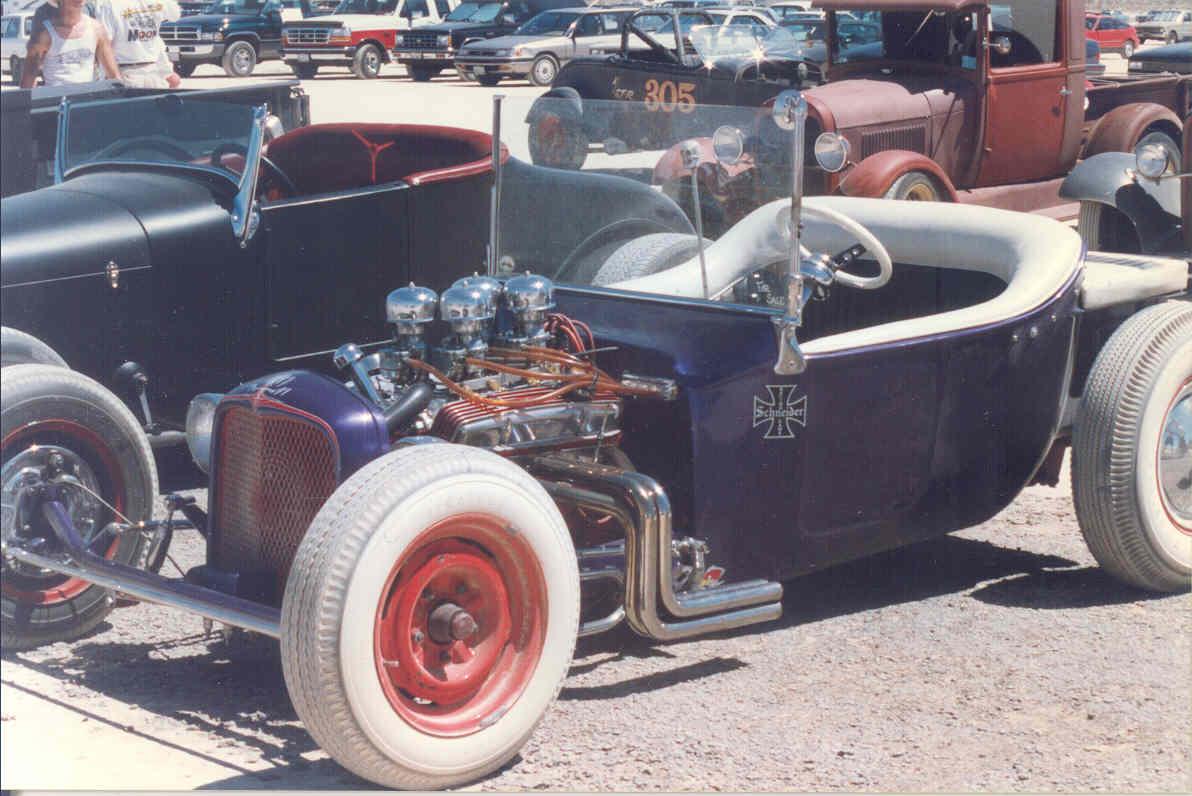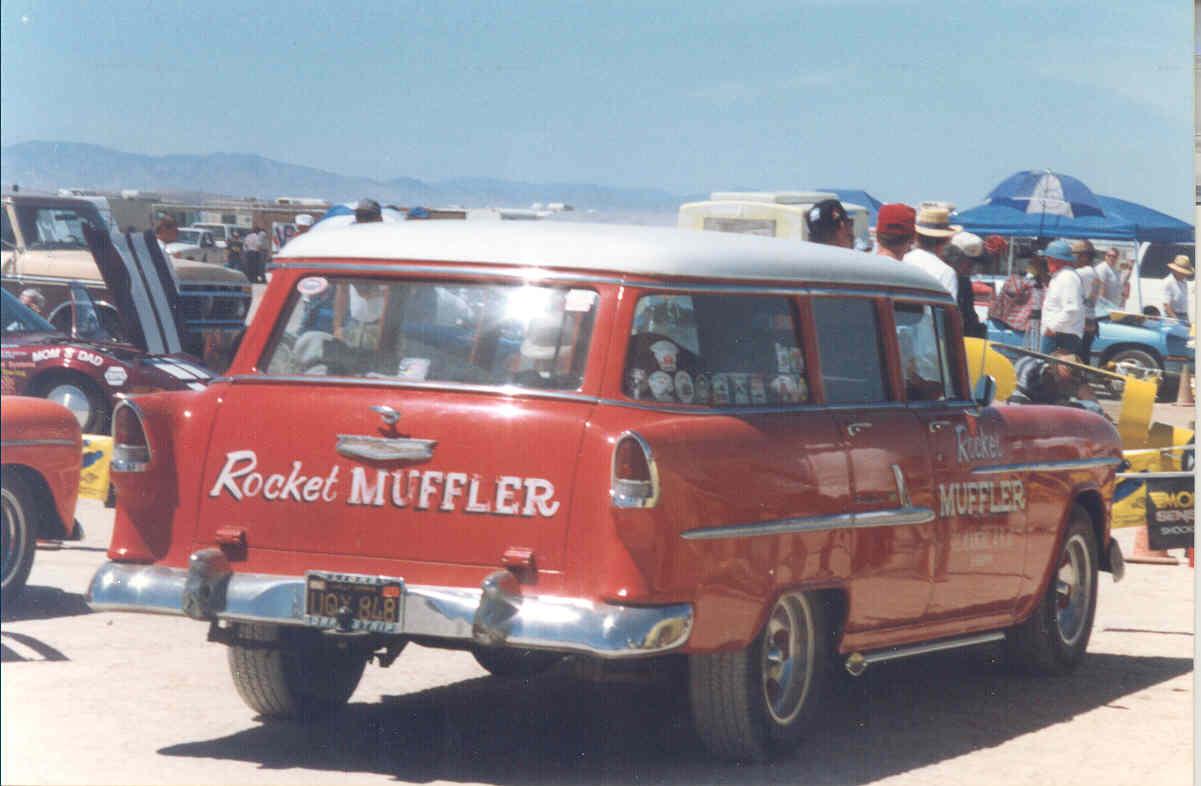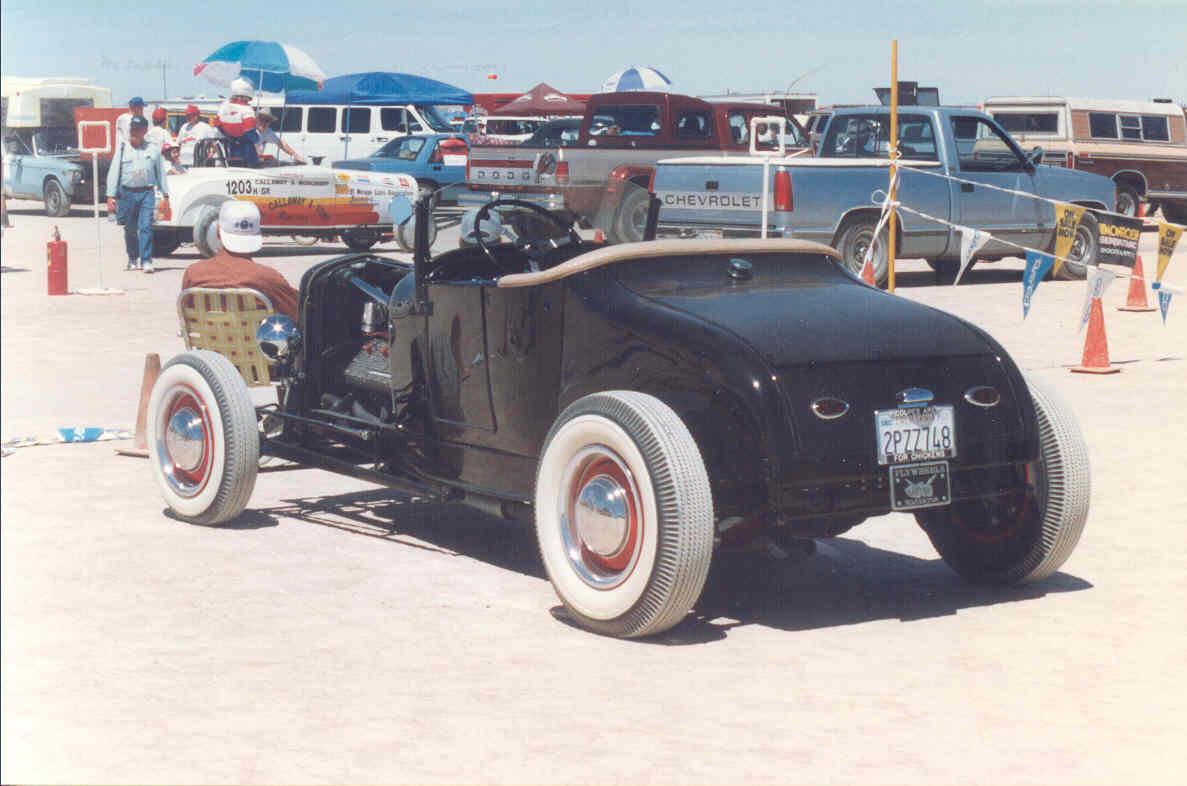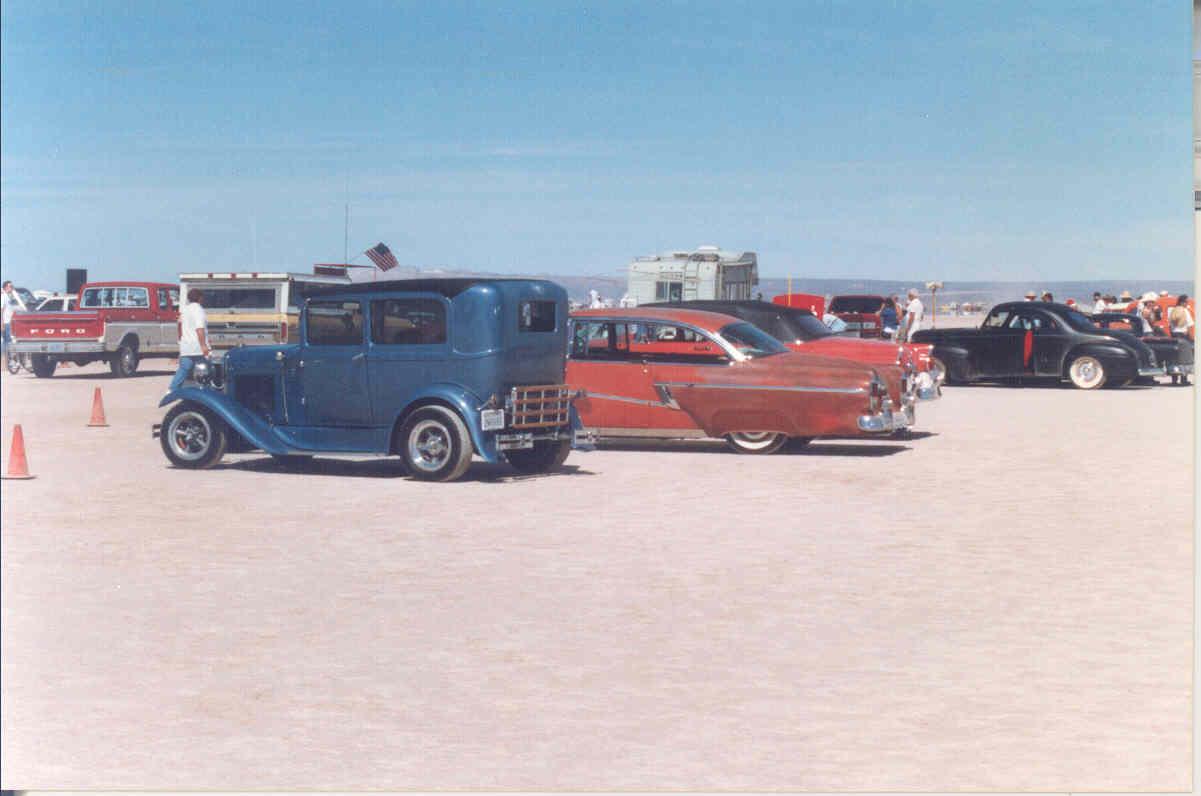-
Posts
364 -
Joined
-
Last visited
Content Type
Profiles
Forums
Events
Gallery
Everything posted by DustyMojave
-
I've always (as a guy who grew up involved in sports car racing and rallying in the late 50s into the 70s) far preferred the appearance of the TR3A and B over the narrow grilled TR2 and 3. In about 1958 or 59 my family took my uncle out shopping for a car as he was recently out of the Marine Corps. One car he nearly bought was a light blue TR2. He wound up buying a more sedate American sedan. He spent far more time haggling over the TR2 than the whole time actually buying the other car. In the early 70s, at the SCCA road races in SoCal I was Tech Inspector before the races, Wreck Impounds and helped the Emergency Crew during the races, then Rules Enforcement post race doing teardowns and inspection to ensure rule compliance. A guy I considered a friend, Dr. Sturm, a Dentist, was racing his TR3A at Riverside Raceway in SCCA events. So I was near the exit end of the Pit Row when I watched Doc come around in a close dice with some others. Then approaching Turn 2, he was one of 3 cars that went off into the dirt. He hit a rain rut about 2' deep and 4' wide from some recent monsoon rains (yeah, it DOES rain in Southern California, just not near as often as back east). The car flipped in an endo. and landed on its nose. His roll bar with rear braces held. But the frame and body of the car folded just in front of the roll bar. Squished Doc fatally. After that us Tech Inspectors in our region pushed for unofficial roll bar rule advising other racers to brace their roll bars forward of the main hoop to prevent that sort of failure. SCCA did not change the rule, so it was unofficial and we couldn't ban any racers who didn't want to go along. But many local racers were convinced and changed their roll bar structures accordingly. If you look at AMT's kit of the 289 Cobra from 1964, it includes a roll bar with a forward brace and no rearward. Also found in other renditions of that tooling including the Sunny "427" version recently sold under the Revell brand (not really a depiction of a 427 Cobra, as it has the same chassis and engine as the 289 kits it's based on - just has the oval nose and big fenders of the 427). This represents Shelby's "factory" roll bar of the time. It's not as good as a full roll cage, nor as good as a full width roll bar with forward braces on both sides. But it was pretty good. I watched Steve McCaslin endo his 427 Cobra in the same area as Doc Sturm about a year later with a roll bar as depicted in the AMT kit. Turned the car into a wadded up piece of aluminum foil. But Steve was fine. Revell's kits of the 427 Cobra from their own tooling have a rear brace and no forward brace.
-
In 73 -75 I was attending college days and working full time nights at a gas station in Sherman Oaks on Sepulveda near Ventura Blvd. Lots of the Mulholland racers would stop in and meet, BS, Bench Race or sometimes do a last minute check of their cars in our station before heading up to one end of the section of Mulholland Drive that was used for street racing. Corvettes, Ferraris, Porsches, Cobra kit cars, etc. Mostly substantially modified. Like Gerald Hall's beautiful gray metallic 914 with really wide Halibrand wheels and matching fenders that for some reason I remember better than most of the rest. Since I was an SCCA Tech Inspector I understood their talk and they understood me, so we had some pretty good conversations. At the time I was looking to buy a VW Bug and was asking everybody who came in with one if they were interested in selling. I wound up buying a 65 Bug that way. One of those I asked was a young guy who lived in the neighborhood who had a 68 Bug with a 2180cc with dual 48IDA Weber carbs, lowered ride height, extra stout sway bar, 13 x 8 rims with BFG T/A tires mounted to '67 5 lug drum brakes. He declined to sell at the time. Then after I bought a 65 and built a Baja Bug out of it with an 1835cc with a single Weber carb, the guy told me his Bug was for sale for $1500, less than I had just spent on the engine for my Baja, not to mention the gear box that cost as much, body work, wheels and tires, roll bar, etc. Then a week later, he stopped in and told me he had a buyer for the car but was waiting for the cash. Then a couple nights later I was working and there were several Mulholland racers in the station talking about the one guy none of them could beat. Then the guy with the Bug rolled in to the other side of the station for some gas. The guys I was talking to all pointed and said that was the guy they were talking about. All these exotic high dollar radical cars, and they were telling me the car they couldn't beat was a VW Bug! Amazing! Of course, Mulholland Drive is a very tight twisty narrow road with few long straights to favor the high horsepower cars or those with aerodynamic advantages. More of a slalom course. A 125cc shifter go kart would probably smoke them all. So the Bug was pretty good for that. But still?!?! Yeah, the movie was very corny and cheesy. A few cool cars in it though.
-

Hands magneisum wheels
DustyMojave replied to Vintage AMT's topic in Model Building Questions and Answers
Back in the 60s I was pretty fond of the Hands mags. I know that some were intended for racing only and were cast magnesium. Some were intended and sold for use on the street and were cast in aluminum. I'm not sure who actually cast the ones that were sold as "Dan Gurney" wheels in the late 60s/early 70s. I've mostly encountered them on VW Bugs in the 4-lug 15" x 5" version. I may still have some of the ones from my original issue 63 Vette kits. Although those models were destroyed in the Sylmar earthquake of '71. -
But they were unreliable and the NASCAR engine as well as the Super Stock engine (not the same engines) were not available to the public and even the racers who got them were not allowed to open them up at all. Thus they were not production engines. Whereas the Ford 427 any Joe Schmoe could go to a Ford dealer and order one and they were in the cars sold from the showroom floor in sufficient quantity to qualify for the rules. The Chevy Mark IV 427 wasn't sold to the public until the '67 year model. In Super Stock classes, Mopar's 426 Max Wedge engine and car were common enough that my older brother had an early 64 Wedge engine car (they got Hemis in early 1964/late 64 year model) that he raced in 67-68 until a crash destroyed it. And it ran 11.27 @ 127mph on its last run even though it was crashing into the opposite guard rail then hit by the competitor, both while in the lights. So it was going 127mph while spinning 270° and backing into the guard rail. Still as it came from the factory with cheater slicks on the steel rear wheels and the 2 into 1 single exhaust still hanging underneath. So, close to 2 seconds quicker than the so-called "Hemi Destroyer" Chevy. Which is no quicker than my old co-worker's 65 Mustang 2+2 with a 289 with dual quads and tubular headers with no traction bars that ran 13.1 through the mufflers as he drove it to work. About the same as that touted for this killer Chevy with aluminum bodywork and bumpers and factory cheater 427 engine.
-
In the late 60s and early 70s, Steve McQueen was a regular at SoCal sports car races where I was a teenager working as a Tech Inspector, Wreck Impounds and corner flagman. He raced a Porsche 910 Spyder for a few years. I Tech Inspected his car several times during that period. Quite a highly competent driver in an area full of others. Steve sometimes showed up at the track driving his VW Bug convertible with a Ford 351 V8 in the back seat. IIRC, That was donated to the Chafee College Automotive Engineering Program upon his death. Interesting connection since that college was founded by the father of Jim Chafee, a guy who was still racing his C/Modified Devin bodied Chevy V8 powered creation painted pink and black and known as the Pink Elephant on the course the same time as Steve with his Porsche. Jim knew his car was no match against McLarens and Lolas and the other then modern cars, but he got kicks out of it. Steve was, unlike some of the celebrities who showed up around the SoCal road races, a pleasant guy. Fun to talk to. Never there to "show off". Just enjoying the sport and deeply involved in it. Like a few others, including Dick Smothers and Jim Garner. I too raced desert motorcycles, later, after Steve had passed away, but encountered quite a few who had known him. I also worked as a Tech Inspector and later racer myself in desert offroad car racing where Steve had raced the famous Baja Boot. Again, he was thought of well there too. To build that pickup, you could use the frame and part of the bed from the 79 Ford Ford F100 4x4 Camper Special kit that has recently been on the market with Firestone markings. John Wayne's 68 F100 in the same color has just been restored and given away with proceeds to the John Wayne Cancer Research Foundation.
-
OK. American Halibrand wheels with center lock wheels use pins like smooth shank lug studs attached to the hub flange that stays in place on the car instead of splines. The pins pass through the wheel and the pressure plate (which is often part of the wheel). Americans DID use spline drives for wire wheels back in the 1930s. The car my dad used for a daily driver when he met mom was a Singer 9 with spline drive knockoff wheels. My brother still has dad's copper knockoff hammer. And the 1st pair of race cars I ever worked on had spline drive knockoff wheels. It was a matched pair of Lotus 11s with beautiful polished aluminum bodies. While my dad re-wired the crappy wiring job with positive ground and sketchy Lucas electricals, my job was to use my little 4-year old fingers to clean the brand new but filthy dirty English wire wheels. Why they would ship a brand new race car with so much attention to making the bodywork look great, then throw filthy, muddy, grimy wheels on it I still don't understand. I didn't know these MGs used centerlock hubs. But I suppose that wire wheels with knockoffs were an option on the production units. So not a leap for them to be approved for FIA racing. All the ones I saw using aluminum or mag wheels used lug studs for US sprint racing because under SCCA rules, if you used centerlocks, then you had to use wire wheels that went with centerlocks on the production car.
-

Sam Auxier 71 Mustang Prostock
DustyMojave replied to vamach1's topic in WIP: Other Racing: Road Racing, Land Speed Racers
Nice model. I AM curious though, as to why this is in the Road Racing and others area when it's a drag race car. ?? Not throwing a Karen fit, just curious. -
The rear valence on an early Mustang is a separate piece of sheet metal from the rear body panel and the rear corners above the bumper are cast zinc pieces. The valence should be overlapping the body rear panel as it is bolted onto it. The shapes in the body rear panel could readily be made of .020 styrene sheet. Glued in place, then the left tapered down to practically zero, while the right side is left standing out proud, but both sides should be molded to the back panel with white glue or something similar that will fill without requiring further grinding and shaping.
-

Jim Clarks #92 Lotus
DustyMojave replied to BIGTRUCK's topic in WIP: Other Racing: Road Racing, Land Speed Racers
This kit was 1st produced by AMT, introduced in late '63 as I got one of these and a Parnelli Jones Watson Offy race winner model for Christmas that year along with a new TV in our brand new house. My brother had recently gotten out of the hospital after getting bitten by a rattlesnake on my birthday. It was a memorable Christmas for me. It was re-issued by AMT a few times. I later got one of these kits with a poster for the inaugural Indy car race at Michigan International Speedway although that should have been a Lotus 38, not a 29. This version this one is built from was re-issued many years later as a triple kit under the MPC name after AMT merged with MPC. I have a couple of that version too. The early ones I built back in the 60s were destroyed along with many other models in a major earthquake in 1971. I also have the IMC Lotus 38. I have long believed that this AMT/MPC Lotus 29 kit was mastered by the same guy who mastered the MPC kit of the Lotus Turbine Indy car of 1968, and the IMC Ford GT kits of the 60s. They all have the same Ford pushrod and DOHC engines with the same gearbox. Virtually identical pieces. And the Lotuses have a similar too narrow and straight sided windscreen. The tires were always too tall for the Lotus. Better suited to the Watson-Offy, although too tall and narrow for that too. The kit is mostly pretty fair in accuracy and can be built to look pretty good. Certainly NOT a Model Factory Hiro kit. But with an original kit price as printed on the box of $1.50, one can hardly expect MFH quality. I came back to edit because I just remembered that my 2nd kit (the MIS one) I built with a poseable steering. I cut the steering rack from the front upper control arms and replaced it with a piece of aluminum tube rack housing with a wire rack. I dechromed and painted some parts for that one too. The exhaust trumpets were paint brush ferrules. The tires came from another source that I can't remember now but were far closer to "correct" for the car. I think it was a cheap toy car and I cut the wheels out to put the tires on the kit Halibrand front wheels and Dunlop rears. That one I did with the #93 Dan Gurney markings. -

Tiger Cobra Duo
DustyMojave replied to Pierre Rivard's topic in WIP: Other Racing: Road Racing, Land Speed Racers
Nice collection of vintage NASCAR racers. Back in about 1970, my grandfather re-painted his 1960 F100. A previous owner had a camper on it and the seal at the back window and other places was worn through the original paint. He mixed his own paint using stuff like oil based porch paint. Mixed it to his own choice of color (tan with a white roof). Then he applied the paint with a brush. His father in law had been a painter for Oldsmobile before he came to LA in 1904 and had later taught grampa how to do it. No sanding between coats. When he sold the truck in about 1990, it was still bright and shiny, even though it had never been parked indoors. So I know painting with a brush CAN be done. Not that I would be able to do a decent job of it, even though I know basically what needs to be done. My congratulations to you. -

IMSA Pinto
DustyMojave replied to Just Jim's topic in WIP: Other Racing: Road Racing, Land Speed Racers
Back in the day I owned a 76 small window Pinto and a 77 big window hatchback ("The Incredible Flying Pinto"). When driving, I preferred the big window and the hatchback was handy. External looks wide. I always preferred the look of the small window. I suppose I should explain that nickname for the '77, since I wrote it out. This one Christmas, my wife and I were supposed to go visit with my inlaws and then with my family down in the San Fernando Valley, about 75-80 miles away. We left the house with me driving and our 1 year old son in his car seat in back. We got about 4 miles from the house where we were passing some onion fields. The car ahead of us went to turn off on a farm road. So I went to step on the brake pedal, but the brake pedal in those with an automatic is quite wide. Too big for the space available. My right foot hit the back side of the brake pedal and pushed it up toward me. The clip that kept the pedal from coming toward me broke and the pedal got caught in my shoe laces. So my right foot was stuck under the pedal and can't apply the brakes. So I grabbed the hand brake and pulled, but it didn't do much. So I took evasive action to the right into the shoulder. The other driver saw me coming and did the same. So I scraped along the side of the other car and that sent me head on toward a berm around the field. Hit that and launched the car in the air. Landed 75 feet out in the plowed field (my buddy and I later measured the marks in the dirt) and bounced to a stop with the rear tires dragging. The front digging into the dirt smashed the bottom of the radiator and rendered it undriveable. The other folks were nice and gave me a ride to our house so I could get my pickup and car trailer to haul it home. No real damage to people or either car otherwise. Broke a glass baking dish of food we were taking for our late Christmas dinner....... -
Looks like my mom in pictures from those days. My folks met at a sports car road race at Palm Springs. Dad was a long time Dry Lakes racer, hot rodder and track roadster driver type of guy who also was involved in Road Racing. When they met, mom was 5'7, 115lbs, early 20s and brunette and attended dry lakes races and looked similar to this young lady. I think I'm gonna save this picture. If mom hadn't passed away at 90 years in 21, I'd show it to her to see if she knew the woman.
-

Tiger Cobra Duo
DustyMojave replied to Pierre Rivard's topic in WIP: Other Racing: Road Racing, Land Speed Racers
Nice work Pierre. I have one of the Sunny Cobras out to get worked on. And a Tiger kit stashed away waiting. I grew up around and involved in SCCA road racing in SoCal, where Shelby had his business. I dtsarted working Tech Inspection in 1963. My dad got a ride around Riverside in 1962 in CSX 2001 when it was painted metallic yellow. In 1968 I was on the crew of a Tiger owned by Ron Dykes and garaged and prepped at my house. Originally built for racing by Doane Spencer at Hollywood Sports Cars. Today it's one of the most celebrated of all Tigers. Picture below. Not my picture. My dad was Crew Chief. One of the other crew members was Jerry Titus' son Rick. We had some wins with it, even though at the start of the year SCCA changed some of the details of the allowed specs for Tigers from how Shelby Homologated it. 260 engine instead of 289. Small port heads. 2bbl carb. Narrower 13" diameter wheels with no knockoffs. So we had to take off the Halibrand kidney beans that were on it and switched to Chassis Engineering modular wheels (Rights to those were later bought by Cragar and they became Cragar Super Trick brand wheels which were really popular on AA/FDs and Funny Cars.) Yes the car was nose heavy and pushed pretty bad. Ron Dykes drove it well. But when he sold it to Whit Collins, Whit jumped out in the lead at Riverside and was running away from the pack, but couldn't handle the push like Ron and drove it straight on into the outside wall at Turn 6. But in its day before SCCA downgraded them, it had smoked more than its share of Corvettes and even some Cobras. No other Production car ever got downgraded like that by SCCA. But in my 1972 Edition of the PCS (Production Car Specifications rule book supposedly based on Homologation for each car), it refers to Rootes as Manufacturer (correct) and the car is listed as "Sunbeam Tiger 260" It had originally been listed as "Shelby Tiger" with a K Code 289, same as GT350s and Series 1 Cobras and Mustangs for A/Sedan/TransAm. The Tiger kit lacks a cross member under the front that I need to do some research to duplicate for my model. The windscreen may be a bit of a challenge too. And I intend to duplicate the air outlet in the front fender. Your Tiger and Cobra are quite cool. I like them both. -

34 Ford 3W Coupe
DustyMojave replied to ModWrench's topic in WIP: Other Racing: Road Racing, Land Speed Racers
Just read through my post above with the pictures and captions. Edited it to add a little here and there and hope it makes more sense in some spots. -

34 Ford 3W Coupe
DustyMojave replied to ModWrench's topic in WIP: Other Racing: Road Racing, Land Speed Racers
After posting those I had the thought that maybe I should provide some captions for those pics. - The '34 Coupe pushed by the F1 is close to the model in this thread. Above them the NASA rocket engine test facility is visible on the hill. Rocket engines get mounted in test stands up near the top of the hill with the exhaust deflected horizontally out over the desert. - Belly tank with flathead power and stretched tank body. The driver is laid down with those small side windows and a little mirror periscope above to see forward. - The fairly famous Scotty's Muffler '34. This car was originally a Coupe. The roof was cut off WAAAYYY back when. It's been raced by the same owner/ partners and family for many decades. - The 2 characters next to the '29 Street Roadster in cowboy hats are me and my then 2 year old son. He's now 28 and going to work in an aircraft factory on advanced stuff that he can't tell us about. He's spent much of his career since he was in High School making a living fabricating offroad race cars and is a Baja 1000 Champion. - 53 Studebaker with Chevy small block with Hilborn stacks - 51 Merc with Merc flathead - Deuce Street Roadster with flat motor - Another Roadster. This one a '27. Since these are pre-digital from prints, the developer flipped the negative for this shot. - This little coupe is from nearby and has run for years at El Mirage. - A sweet little 27 roadster under construction with a small block Chevy and a track nose. The shot of the grille may help you guys who want to make such grilles for your models to see how that cast grille was made and how to fabricate one. Many racers with track noses had grilles made of steel strap stock and steel sheet. The original used to mold this one was probably made that way, like most all of them, including Kurtis. - My then daily driver 1-owner Falcon Wagon. Bought new by my grandparents. Still rolling with a 6-in-a-row. Bit of patina on the Earl Scheib $29.95 paint job from the early 70s when it had been sandblasted in a sand storm near Palm Springs. Put 145K miles on it in 4 years back then. Still have it. - Cool little 25 T Roadster with a Model C (33-34 with pressure oiling, but otherwise same block as a Model A) 4-banger in it. I've seen this car at El Mirage quite a few times over the years. - Another 25 T Roadster. IIRC, this one was out of Ed Winfield's shop which then had just recently been moved to the desert west of Edwards AFB. - Nice Double Nickel wagon. - 27 on Deuce Rails with a Flathead and a Duval windshield. In the background is George Callaway's 29 Roadster. At that time George's car was running a Toyota 4 cylinder engine. George's home is on the west edge of El Mirage and is the only property that has deeded access to the lakebed. Every one else has to go through the BLM Gate at the east end of the lakebed and pay BLM for entry. - Some cool cars parked on the lakebed. - Sweet roadster with a Duval Window. Streamliner beyond it. Some more pics: 1st is a streamliner that I worked on years ago. Basso, Klos & Kong. One of the partners, Ray Basso was a close friend of mine. Another partner was Kong Jackson, who's Kong ignitions for flatheads famous since shortly after WWII. His brother Pete is famous for his gear cam drives. I'm visible beyond the canopy. Body boy Jocko Engine is one of many flathead engines owned by Ray Basso and built by Ray and Kong. All of those engines are special in some way or another. Kong heads. Riley Single Port OHV (one intake port per head as required by rules for a certain class of race boats in the late 40s/early 50s). Ardun (Ray had 3 sets of Ardun heads) with SCOT blower. Flat Plane Crank Merc block (sounds like 2 separate 4 cylinder engines running). He had a garage load of engines. 4-Bangers like Riley and Cragar OHVs, V8s, even had an early 50s 255 Offy and a 1970s Turbo Offy Indy engine from Vel's/Parnelli Jones team. Hell, why don't I throw in a picture or 2 of the Tom Beatty belly Tank. One pic is the car at Laguna Seca for the Historic weekend and now lives in the Henry Ford Museum. The other is at El Mirage in 58 to 60. Skinny Tom and Fat Eddy who worked for Tom. (PS: The man went by Fat Eddy. He would introduce himself to folks who walked into the shop that way. VERY nice guy. Used to always give me a nickel to get a soda out of the vending machine in the shop.) That pic is by my dad and is copyright RP 2015. Note the "nipple" on the original to the car front wheel cover in the Laguna Seca photo. Before Dean Moon produced his salt discs, Tom made his own out of lids for wringer washing machines. Took off the spot welded handle and trimmed the edge to fit the wheel. Last is me sitting in the Kelly & Hall Belly Tank also at El Mirage about 10 years ago. -

34 Ford 3W Coupe
DustyMojave replied to ModWrench's topic in WIP: Other Racing: Road Racing, Land Speed Racers
Just 'cuz ModWrench said a while back "I am interested in hearing more, so feel free to post up your insights and stories. You won't offend me if you do it here! " And I was struggling with cancer at the time, I didn't follow up. Doing better now after some radiation treatments and some medicine. So I was checking out the thread and thought I'd throw down a few photos from the Muroc Reunion from 1996. The organization that has run events at Bonneville each August and aside from August, from April through November at El Mirage is SCTA. A few dry lake beds in SoCal were used before WWII and up into the 1950s. -Muroc Dry Lake: Since WWII has been Edwards Air Force Base. The space shuttles landed on this dry lake bed. The 1st plane to break the speed of sound did so above this lakebed after taking off from it. So racers had not been allowed to use it since the Army Air Corps took over. But in 1996, the commander allowed an event to take place. Most all of the modern Air Force planes, like SR71 Blackbirds, F16s, F22s, F117 NightHawk (the 1st stealth fighter), B1B (1st stealth bomber), B2, F35 and many more have been test flown from Edwards. - Harper's Dry Lake: Northeast of Edwards and northwest of Barstow. Mostly used by Russetta Timing Assn, who competed with SCTA and allowed coupes when SCTA did not. - El Mirage: Southeast of Edwards and not far from my house. This was the most used SoCal dry lake bed. An old friend of mine, Wes Cooper, told me when he was 14 in 1927, he and his mom had taken a drive in mom's Model T and were stopped in what later became the City of Santa Clarita getting gas and some dry lakes racers came in for gas. He was checking out the race cars and talking to the guys, when they told him and his mom about the races they were going to out at El Mirage. He was so enthused, that mom agreed they could go out to the race. So they tagged along. The roads were mostly dirt from there and the next 50+ miles through the Sierra Pelona Mountains to Palmdale, and then across the desert to El Mirage. He was hooked and attended nearly every event until he passed away in the mid-90s near the finish line holding a time slip from his 34 Coupe (Cooper, Donovan & Creel) having just set a new record for a flathead powered coupe. El Mirage is still the location for races for most of the season. -
Cool. I've always been a little fond of the quirky styling of these cars. When I was in high school in the early 1970s, (San Fernando High in SoCal) my school was overflowing with lowriders. Not many of us were into go-fast cars. But one guy bought a '62 Valiant 2 door. Replaced the slant 6 with a 426 hemi with tunnel ram, Dana 60 rear axle, modified front suspension, roll cage, 12" cheater slicks, and lots of drag racing bits. The original deck had the fakey continental kit. He found a plain one as shown on these models and put that on. Painted the car bright yellow. Was a great deal like the green one above. Had permission from the Principal to do occasional burnouts in the driveway past the cafeteria at lunch time. Same Principal also promoted a lowrider car show with hydraulic lift hopping competition on the PE field.
-

Super Gas '77 Vega--Completed! (11/12)
DustyMojave replied to Straightliner59's topic in WIP: Drag Racing Models
I'm not a Chevy guy, nor much into drag racing. But I like this build. Maybe in part because an old friend in my little town has one JUST like this, even the red color, hood scoop and wheels! He's a retired UPS mechanic and built it himself about 20 years ago. 4-bolt main small block with a single 4bbl and Power Slide trans, 10,000RPM torque converter. Narrowed 9in on Alston links. Vega front suspension. Runs high 9s in the 1/4. Of course, being built by Straightliner59, the details on this build are over the top for a curbside! -
Pretty cool! From a way off, the injector stacks look like the real deal, but the AFB lurking underneath is a slightly different story. Keeps it streetable. The A/G is an indicator of someone who doesn't know what's right, as it represents an "Altered" not a "gasser", but that's a minor detail. So here's some help building a model of it: https://atlantis-models.com/keelers-kustoms-yellow-fever-competition-coupe-1-25-made-in-the-usa/ (Yep, I have mine!) This body and chassis and engines came as Revell Parts Pack kits back in the early-mid 60s. They haven't been produced since the mid 60s. Atlantis is planning to bring out some others as well, they already produce the Mooneyes dragster kit which has some altered parts in it including the frame Revell used for the T altered. The old AMT Double Dragster kit is another source of a body and chassis. AMT offers a chassis in their Parts Packs. Jimmy Flintstone and I think Fremont Racing make resin bodies too.
-

1989 Ford IMSA Mustang
DustyMojave replied to Reeves Racing's topic in Other Racing: Road Racing, Salt Flat Racers
If you wanna do the Camaro more correct with a Chevy engine, the one out of the Revell '69 Z28 would be a good choice. Intake maybe form an AMT NASCAR kit, or maybe even the whole engine from the NASCAR kit to keep it simple. Airbox would need to be scratch built probably. The small bell housing and Nash 5 speed trans in the Mustang and Camaro kits would be correct. To cheat and make it EZ, just put Chevy valve covers on the kit Ford engine. Mighty few who saw the built car would know, other than you. PS... I worked on full scale race cars of this sort, as fabricator and crew member, from Elliott Forbes-Robinson's Buick, to Les Lindley's Camaro, to Rick Ware's Corvette. And I don't consider the differences between IMSA GTO rules and SCCA Trans Am rules to be sufficient or detectable enough to matter in 1/25 scale. Many cars raced in both series over the years. And many chassis got be-bodied with a different body and different engine. Some IMSA GTO cars wound up racing in SCCA GT1 and other series. Decals will make the difference depending on which car at what time in its career is being modeled. If you have reference photos, go for it building from those. -
This is a relevant picture. Note the car in the background. Not the same Mopar, or even the same exact year or model. But very similar, same body shell. This pic was taken by my dad in the late 50s, like 58 to 60, at El Mirage Dry Lake. Dad's best friend, Tom Beatty with his employee Fat Eddy with Tom's belly tank in line for the start. Shows that dry lakes racers considered these Mopars to be sleek and desirable cars in those days. When I 1st saw Curt's posts about this model, I was quite impressed with his conversion of the AMT '58 Belvedere into a '57 Savoy. Not a huge change, but not as easy as Curt made it out to be. Such work takes advanced model building skills.
-

Monogram Ferrari 308 GTB Racer
DustyMojave replied to JTalmage's topic in Other Racing: Road Racing, Salt Flat Racers
Beautiful model I never ran across that kit, not even in a catalog. And in the 1980s I worked for Mattel Toys when they owned Monogram. Great job building it, even if it was a quick build.





